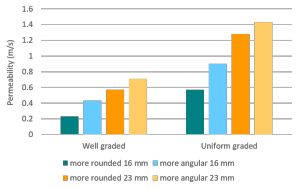Aggregates
Revision as of 18:03, 23 January 2018 by Jenny Hill (talk | contribs)
Reservoir Stone[edit]
The important characteristics of the stone within the reservoir or underdrain are the lack of fines, the void ratio and (to a lesser extent) the permeability. Porosity and permeability are directly influenced by the size, gradation and angularity of the particles [1]
Stone for erosion control[edit]
Aggregates used to line swales or otherwise dissipate energy (e.g. in forebays)should have high angularity to increase the permissible shear stress applied by the flow of water. However, in some surface landscaped applications there may be a desire to use a rounded aggregate such as 'river rock' for aesthetic reasons.
- ↑ Judge, Aaron, "Measurement of the Hydraulic Conductivity of Gravels Using a Laboratory Permeameter and Silty Sands Using Field Testing with Observation Wells" (2013). Dissertations. 746. http://scholarworks.umass.edu/open_access_dissertations/746

